2023 TOYOTA 86 light
[x] Cancel search: lightPage 184 of 449
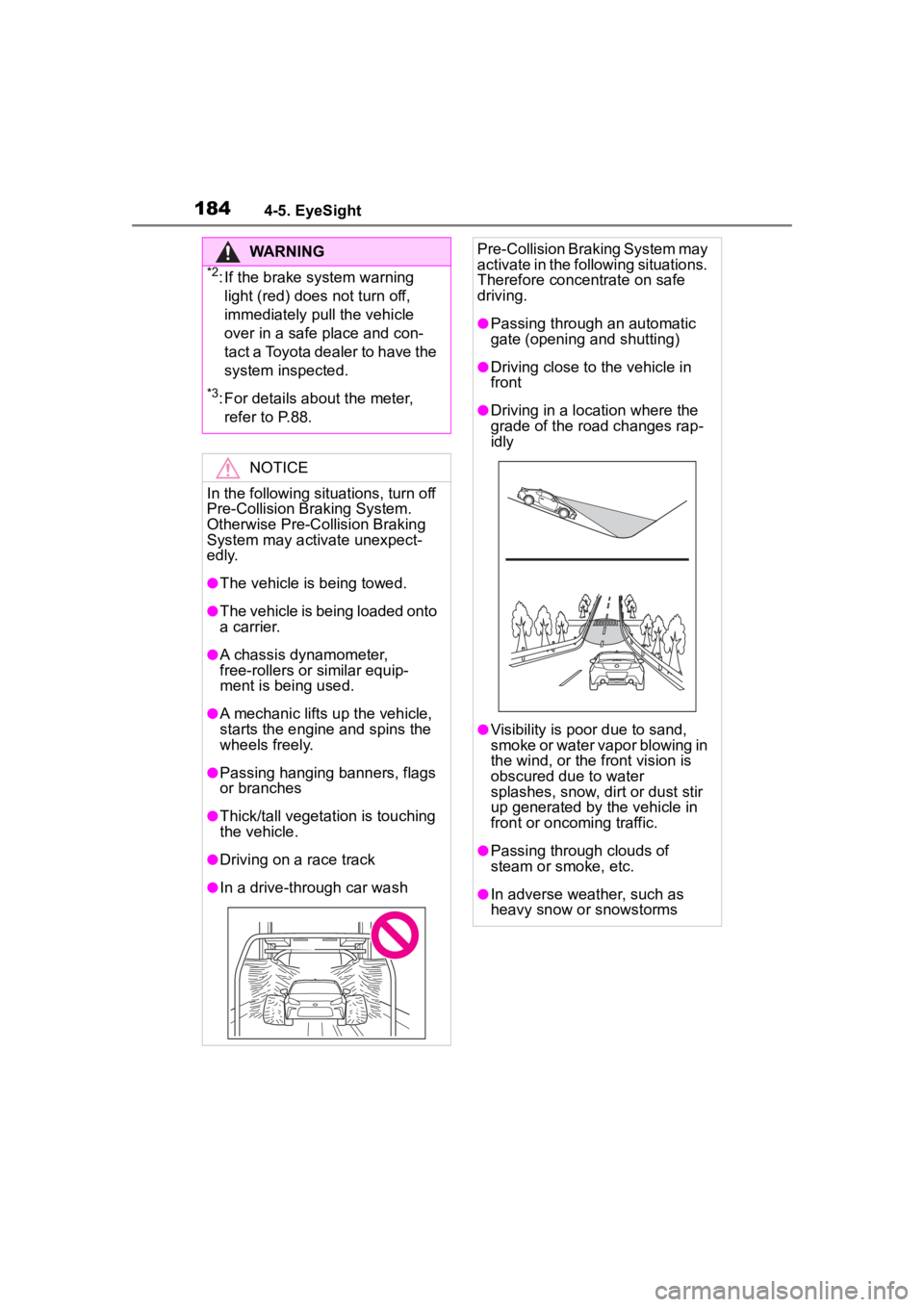
1844-5. EyeSight
WARNING
*2: If the brake system warning light (red) does not turn off,
immediately pull the vehicle
over in a safe place and con-
tact a Toyota dealer to have the
system inspected.
*3: For details about the meter,
refer to P.88.
NOTICE
In the following situations, turn off
Pre-Collision Braking System.
Otherwise Pre-Collision Braking
System may activate unexpect-
edly.
●The vehicle is being towed.
●The vehicle is being loaded onto
a carrier.
●A chassis dynamometer,
free-rollers or similar equip-
ment is being used.
●A mechanic lifts up the vehicle,
starts the engine and spins the
wheels freely.
●Passing hanging banners, flags
or branches
●Thick/tall vegeta tion is touching
the vehicle.
●Driving on a race track
●In a drive-through car wash
Pre-Collision Braking System may
activate in the following situations.
Therefore concentrate on safe
driving.
●Passing through an automatic
gate (opening and shutting)
●Driving close to the vehicle in
front
●Driving in a loc ation where the
grade of the road changes rap-
idly
●Visibility is poor due to sand,
smoke or water vapor blowing in
the wind, or the front vision is
obscured due to water
splashes, snow, dirt or dust stir
up generated by the vehicle in
front or oncoming traffic.
●Passing through clouds of
steam or smoke, etc.
●In adverse weather, such as
heavy snow or snowstorms
Page 186 of 449
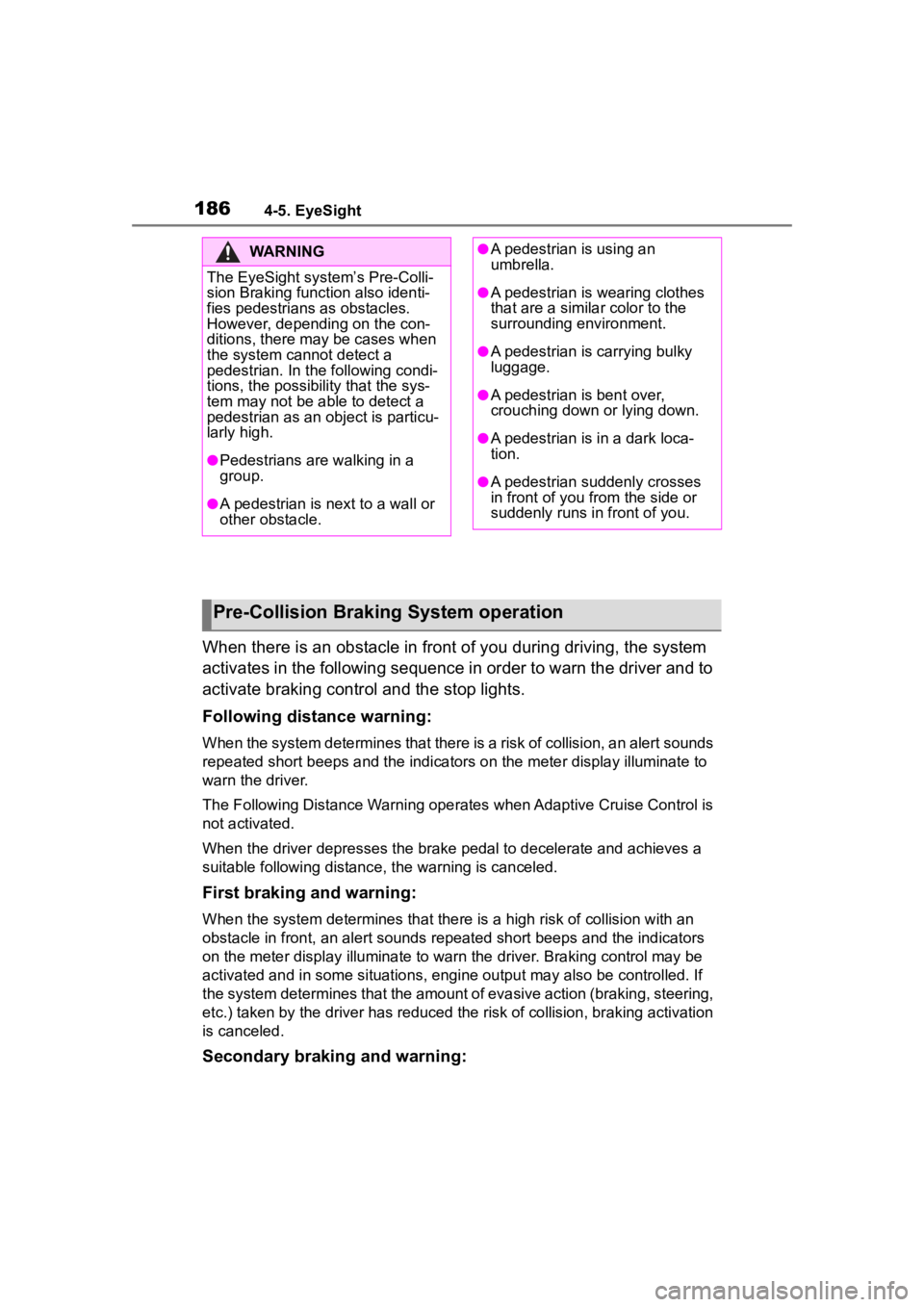
1864-5. EyeSight
When there is an obstacle in front of you during driving, the system
activates in the following sequence in order to warn the driver and to
activate braking control and the stop lights.
Following distance warning:
When the system determines that t here is a risk of collision, an alert sounds
repeated short beeps and the indicators on the meter display il luminate to
warn the driver.
The Following Distance Warning ope rates when Adaptive Cruise Control is
not activated.
When the driver depresses the bra ke pedal to decelerate and achieves a
suitable following distanc e, the warning is canceled.
First braking and warning:
When the system determines that there is a high risk of collisi on with an
obstacle in front, an alert sounds repeated short beeps and the indicators
on the meter display illuminate to warn the driver. Braking control may be
activated and in some situations, engine output may also be controlled. If
the system determines that the amount of evasive action (brakin g, steering,
etc.) taken by the driver has reduced the risk of collision, br aking activation
is canceled.
Secondary braking and warning:
WARNING
The EyeSight system’s Pre-Colli-
sion Braking function also identi-
fies pedestrians as obstacles.
However, depending on the con-
ditions, there may be cases when
the system cannot detect a
pedestrian. In the following condi-
tions, the possibility that the sys-
tem may not be able to detect a
pedestrian as an object is particu-
larly high.
●Pedestrians are walking in a
group.
●A pedestrian is next to a wall or
other obstacle.
●A pedestrian is using an
umbrella.
●A pedestrian is wearing clothes
that are a similar color to the
surrounding environment.
●A pedestrian is carrying bulky
luggage.
●A pedestrian is bent over,
crouching down o r lying down.
●A pedestrian is in a dark loca-
tion.
●A pedestrian suddenly crosses
in front of you from the side or
suddenly runs in front of you.
Pre-Collision Braki ng System operation
Page 187 of 449
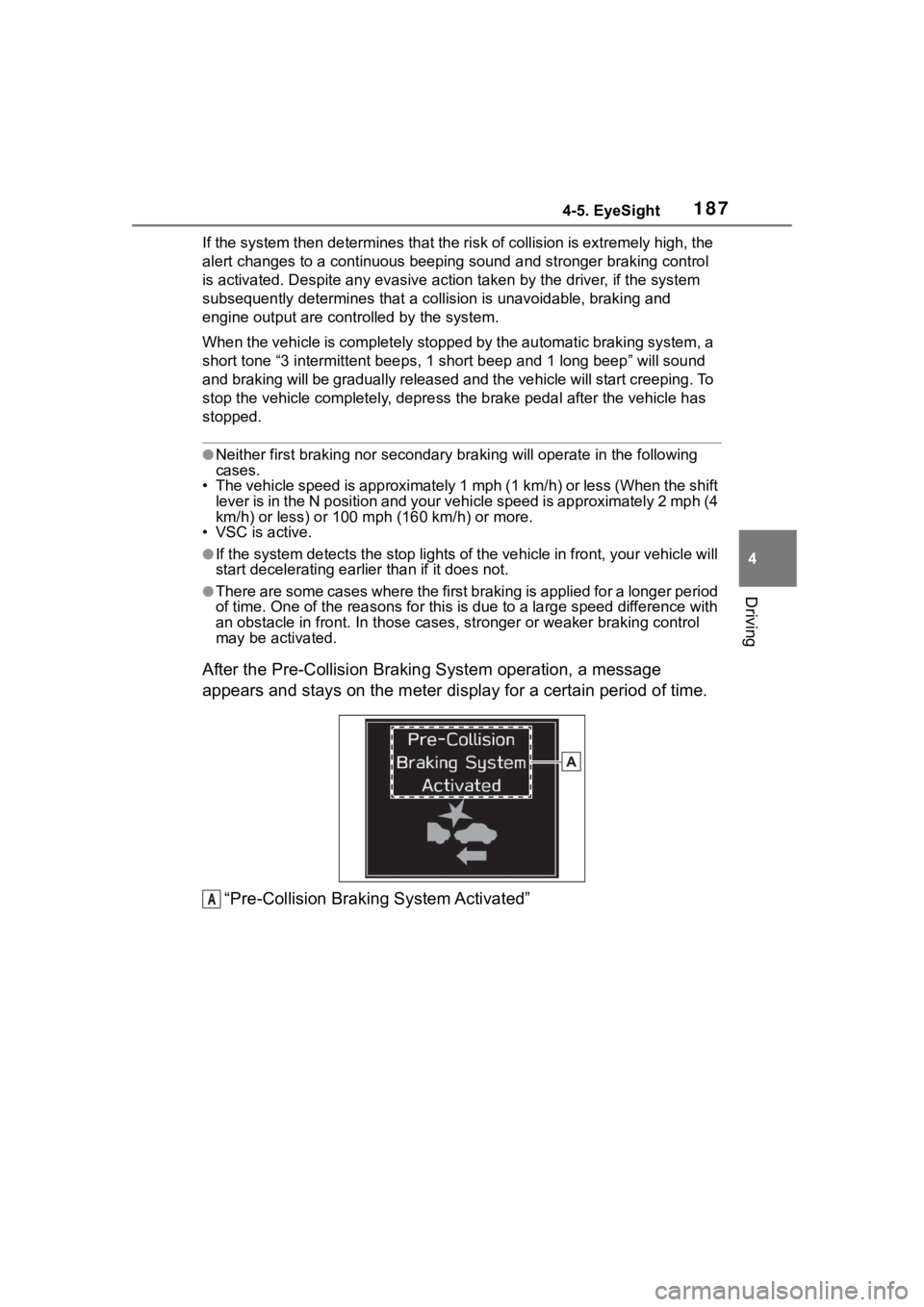
1874-5. EyeSight
4
Driving
If the system then determines that the risk of collision is ext remely high, the
alert changes to a continuous beeping sound and stronger brakin g control
is activated. Despite any evasive action taken by the driver, if the system
subsequently determine s that a collision is unavoidable, brakin g and
engine output are con trolled by the system.
When the vehicle is completely stopped by the automatic braking system, a
short tone “3 intermittent beeps , 1 short beep and 1 long beep” will sound
and braking will be gradually released and the vehicle will sta rt creeping. To
stop the vehicle completely, d epress the brake pedal after the vehicle has
stopped.
●Neither first braking nor secondary braki ng will operate in the following
cases.
• The vehicle speed is approximately 1 mph (1 km/h) or less (Whe n the shift
lever is in the N position and your vehicle speed is approximat ely 2 mph (4
km/h) or less) or 100 mph (160 km/h) or more.
• VSC is active.
●If the system detects the stop lights of the vehicle in front, your vehicle will
start decelerating earlier than if it does not.
●There are some cases where the first braking is applied for a l onger period
of time. One of the reasons for t his is due to a large speed difference with
an obstacle in front. In those cases, stronger or weaker brakin g control
may be activated.
After the Pre-Collision Braki ng System operation, a message
appears and stays on the meter display for a certain period of time.
“Pre-Collision Braking System Activated”
A
Page 191 of 449
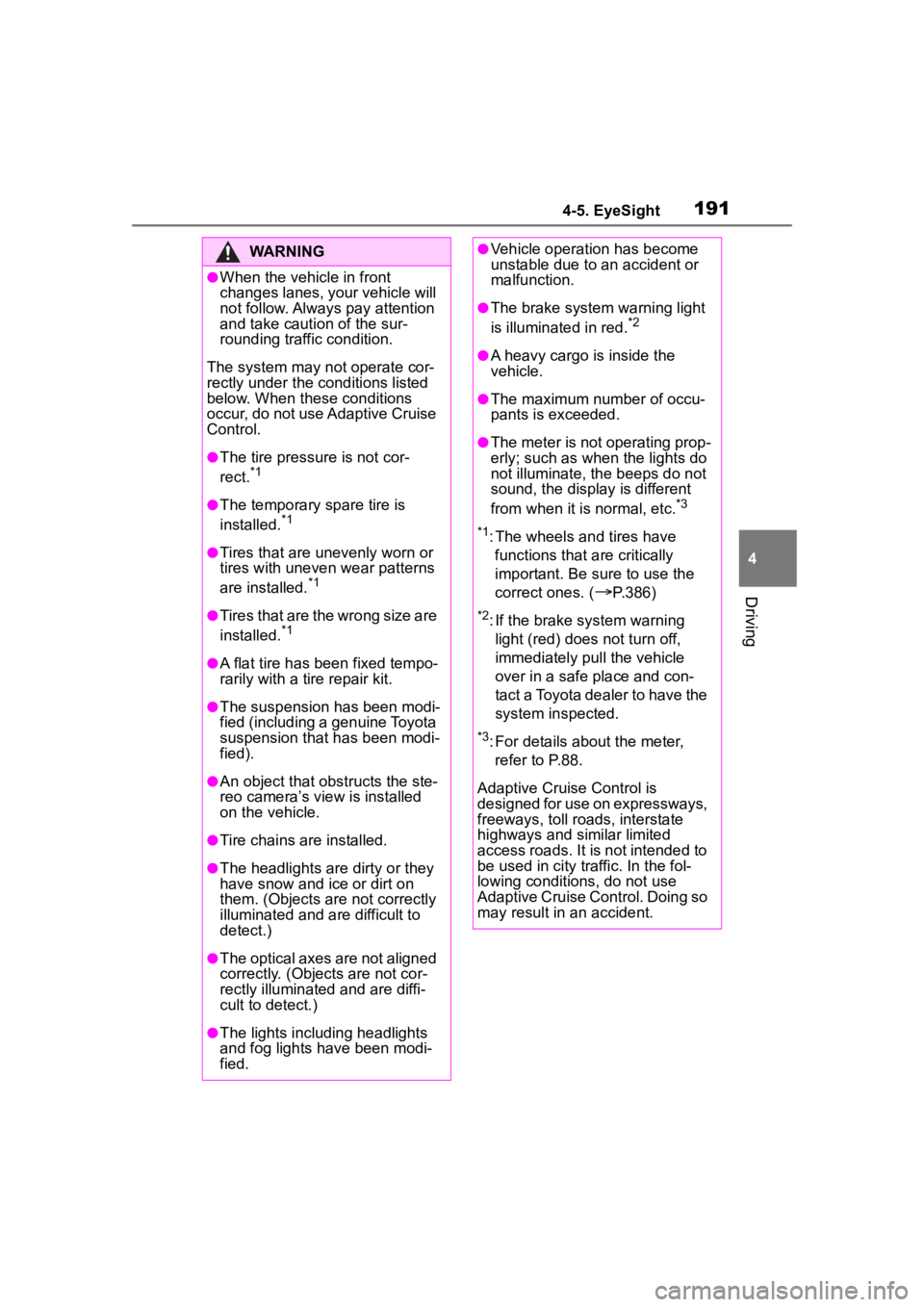
1914-5. EyeSight
4
Driving
WARNING
●When the vehicle in front
changes lanes, your vehicle will
not follow. Always pay attention
and take caution of the sur-
rounding traffic condition.
The system may not operate cor-
rectly under the c onditions listed
below. When these conditions
occur, do not use Adaptive Cruise
Control.
●The tire pressure is not cor-
rect.*1
●The temporary spare tire is
installed.*1
●Tires that are u nevenly worn or
tires with uneven wear patterns
are installed.
*1
●Tires that are the wrong size are
installed.*1
●A flat tire has been fixed tempo-
rarily with a tire repair kit.
●The suspension has been modi-
fied (including a genuine Toyota
suspension that has been modi-
fied).
●An object that obstructs the ste-
reo camera’s view is installed
on the vehicle.
●Tire chains are installed.
●The headlights are dirty or they
have snow and ice or dirt on
them. (Objects are not correctly
illuminated and are difficult to
detect.)
●The optical axes are not aligned
correctly. (Objects are not cor-
rectly illuminate d and are diffi-
cult to detect.)
●The lights including headlights
and fog lights have been modi-
fied.
●Vehicle operation has become
unstable due to an accident or
malfunction.
●The brake system warning light
is illuminated in red.*2
●A heavy cargo is inside the
vehicle.
●The maximum number of occu-
pants is exceeded.
●The meter is not operating prop-
erly; such as when the lights do
not illuminate, the beeps do not
sound, the display is different
from when it is normal, etc.
*3
*1
: The wheels and tires have functions that are critically
important. Be sure to use the
correct ones. (
P.386)
*2: If the brake s ystem warning
light (red) does not turn off,
immediately pull the vehicle
over in a safe place and con-
tact a Toyota dealer to have the
system inspected.
*3: For details about the meter, refer to P.88.
Adaptive Cruise Control is
designed for use on expressways,
freeways, toll roads, interstate
highways and similar limited
access roads. It is not intended to
be used in city traffic. In the fol-
lowing conditions, do not use
Adaptive Cruise Control. Doing so
may result in an accident.
Page 193 of 449
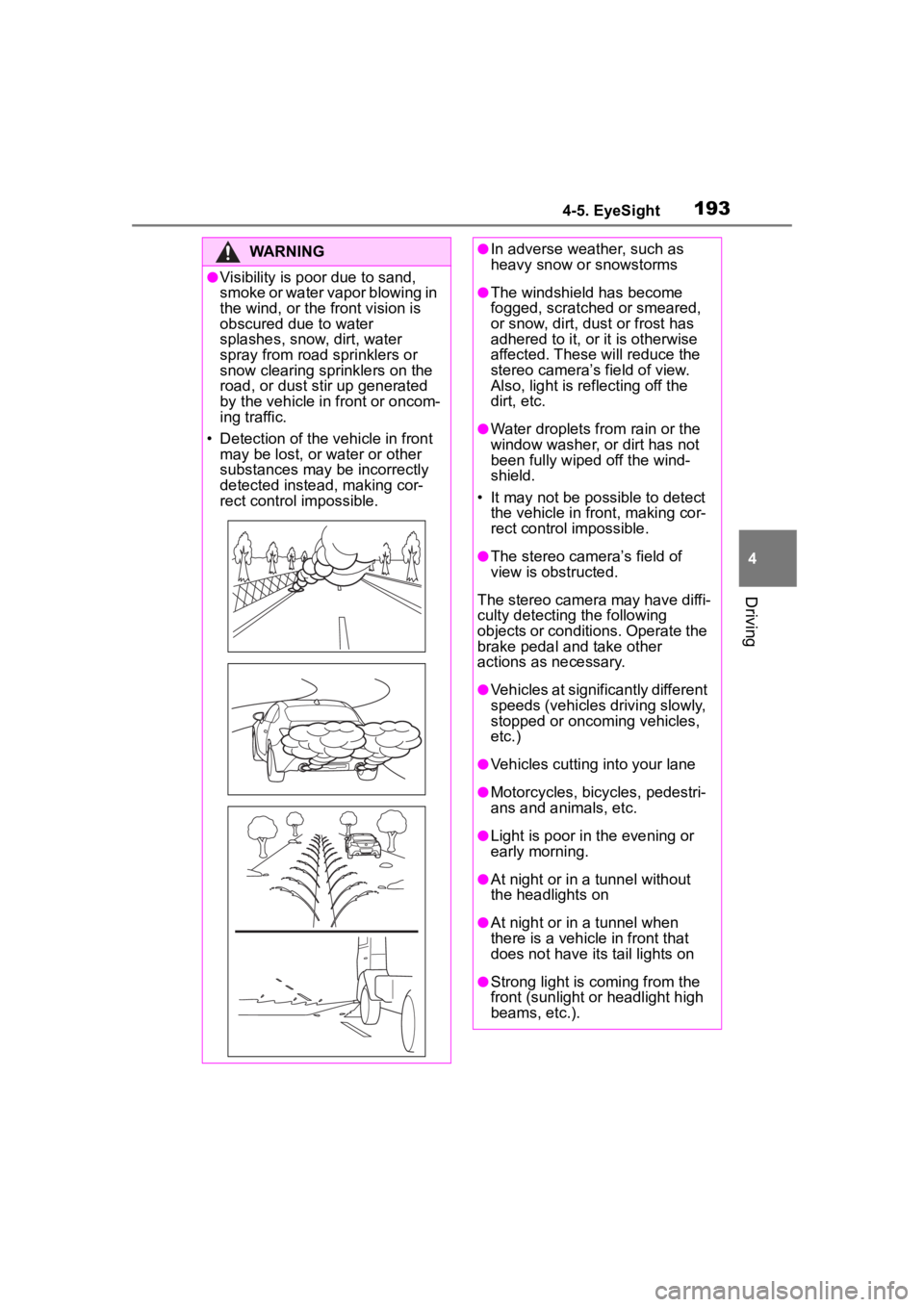
1934-5. EyeSight
4
Driving
WARNING
●Visibility is poor due to sand,
smoke or water vapor blowing in
the wind, or the front vision is
obscured due to water
splashes, snow, dirt, water
spray from road sprinklers or
snow clearing sprinklers on the
road, or dust stir up generated
by the vehicle in front or oncom-
ing traffic.
• Detection of the vehicle in front may be lost, or water or other
substances may be incorrectly
detected instead, making cor-
rect control impossible.
●In adverse weather, such as
heavy snow or snowstorms
●The windshield has become
fogged, scratched or smeared,
or snow, dirt, dust or frost has
adhered to it, or it is otherwise
affected. These will reduce the
stereo camera’s field of view.
Also, light is reflecting off the
dirt, etc.
●Water droplets from rain or the
window washer, or dirt has not
been fully wiped off the wind-
shield.
• It may not be possible to detect the vehicle in front, making cor-
rect control impossible.
●The stereo camer a’s field of
view is obstructed.
The stereo camera may have diffi-
culty detecting the following
objects or conditions. Operate the
brake pedal and take other
actions as necessary.
●Vehicles at significantly different
speeds (vehicles driving slowly,
stopped or oncoming vehicles,
etc.)
●Vehicles cutting into your lane
●Motorcycles, bicycles, pedestri-
ans and animals, etc.
●Light is poor in the evening or
early morning.
●At night or in a tunnel without
the headlights on
●At night or in a tunnel when
there is a vehicle in front that
does not have its tail lights on
●Strong light is coming from the
front (sunlight or headlight high
beams, etc.).
Page 199 of 449
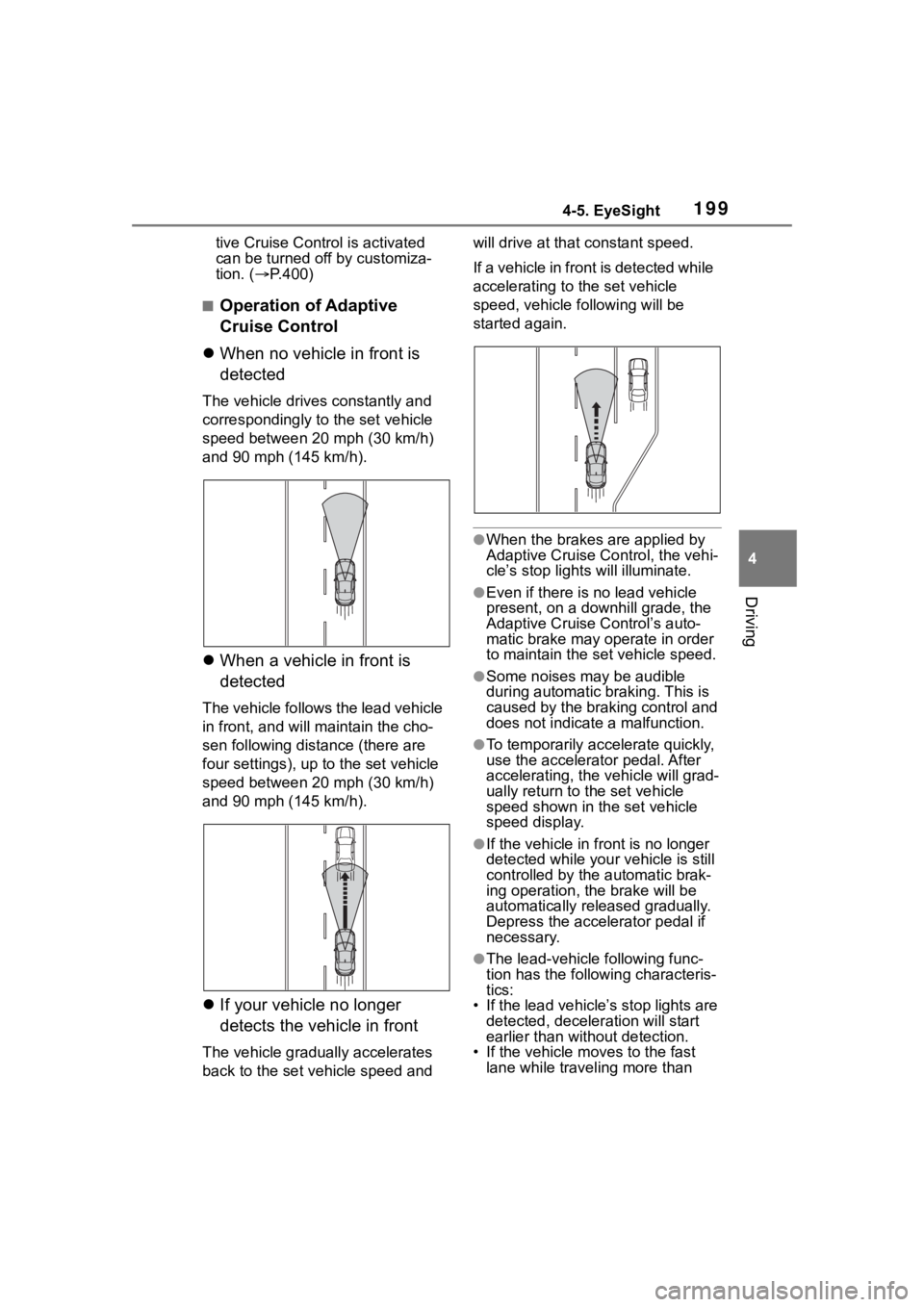
1994-5. EyeSight
4
Driving
tive Cruise Control is activated
can be turned off by customiza-
tion. (P.400)
■Operation of Adaptive
Cruise Control
When no vehicle in front is
detected
The vehicle drives constantly and
correspondingly to the set vehicle
speed between 20 mph (30 km/h)
and 90 mph (145 km/h).
When a vehicle in front is
detected
The vehicle follows the lead vehicle
in front, and will maintain the cho-
sen following distance (there are
four settings), up to the set vehicle
speed between 20 mph (30 km/h)
and 90 mph (145 km/h).
If your vehicle no longer
detects the vehicle in front
The vehicle gradually accelerates
back to the set vehicle speed and will drive at that constant speed.
If a vehicle in fron
t is detected while
accelerating to the set vehicle
speed, vehicle following will be
started again.
●When the brakes are applied by
Adaptive Cruise Co ntrol, the vehi-
cle’s stop lights will illuminate.
●Even if there is no lead vehicle
present, on a downhill grade, the
Adaptive Cruise Control’s auto-
matic brake may op erate in order
to maintain the set vehicle speed.
●Some noises may be audible
during automatic braking. This is
caused by the braking control and
does not indicate a malfunction.
●To temporarily acce lerate quickly,
use the accelerator pedal. After
accelerating, the v ehicle will grad-
ually return to the set vehicle
speed shown in the set vehicle
speed display.
●If the vehicle in front is no longer
detected while your vehicle is still
controlled by the automatic brak-
ing operation, the brake will be
automatically released gradually.
Depress the accelerator pedal if
necessary.
●The lead-vehicle following func-
tion has the following characteris-
tics:
• If the lead vehicle’s stop lights are
detected, deceler ation will start
earlier than without detection.
• If the vehicle moves to the fast
lane while traveling more than
Page 216 of 449
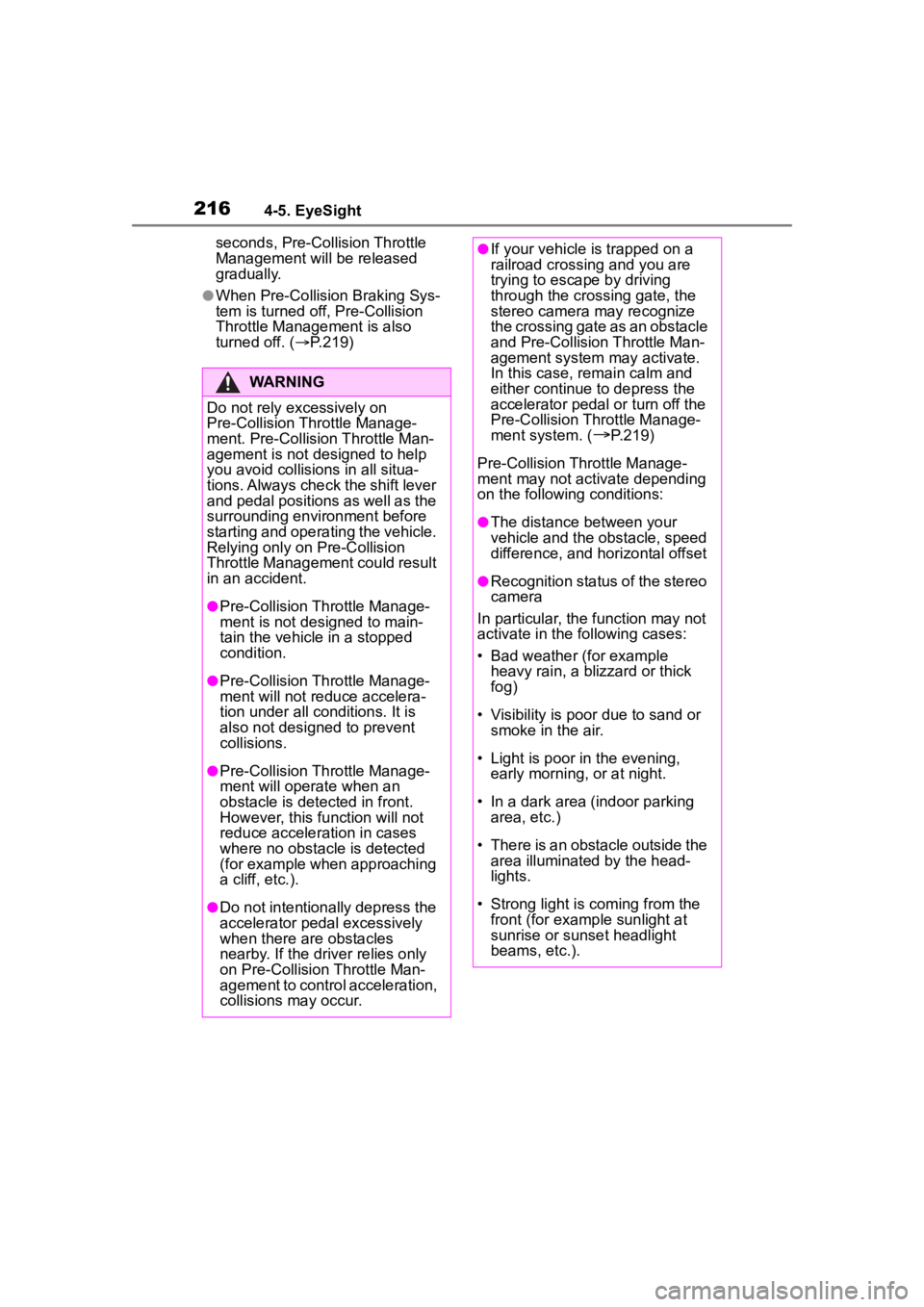
2164-5. EyeSight
seconds, Pre-Collision Throttle
Management will be released
gradually.
●When Pre-Collision Braking Sys-
tem is turned off, Pre-Collision
Throttle Management is also
turned off. ( P.219)
WARNING
Do not rely excessively on
Pre-Collision Throttle Manage-
ment. Pre-Collisi on Throttle Man-
agement is not designed to help
you avoid collisions in all situa-
tions. Always check the shift lever
and pedal positions as well as the
surrounding environment before
starting and operating the vehicle.
Relying only on Pre-Collision
Throttle Management could result
in an accident.
●Pre-Collision Throttle Manage-
ment is not designed to main-
tain the vehicle in a stopped
condition.
●Pre-Collision Throttle Manage-
ment will not reduce accelera-
tion under all conditions. It is
also not designed to prevent
collisions.
●Pre-Collision Throttle Manage-
ment will operate when an
obstacle is detected in front.
However, this function will not
reduce accelera tion in cases
where no obstacle is detected
(for example when approaching
a cliff, etc.).
●Do not intentionally depress the
accelerator pedal excessively
when there are obstacles
nearby. If the driv er relies only
on Pre-Collision Throttle Man-
agement to control acceleration,
collisions may occur.
●If your vehicle is trapped on a
railroad crossing and you are
trying to escape by driving
through the crossing gate, the
stereo camera may recognize
the crossing gate as an obstacle
and Pre-Collision Throttle Man-
agement system may activate.
In this case, rem ain calm and
either continue to depress the
accelerator pedal or turn off the
Pre-Collision Throttle Manage-
ment system. (
P.219)
Pre-Collision Throttle Manage-
ment may not activate depending
on the following conditions:
●The distance between your
vehicle and the obstacle, speed
difference, and horizontal offset
●Recognition status of the stereo
camera
In particular, the function may not
activate in the following cases:
• Bad weather (for example heavy rain, a blizzard or thick
fog)
• Visibility is poor due to sand or
smoke in the air.
• Light is poor in the evening, early morning, or at night.
• In a dark area (indoor parking area, etc.)
• There is an obstacle outside the area illuminated by the head-
lights.
• Strong light is coming from the front (for example sunlight at
sunrise or sunset headlight
beams, etc.).
Page 230 of 449
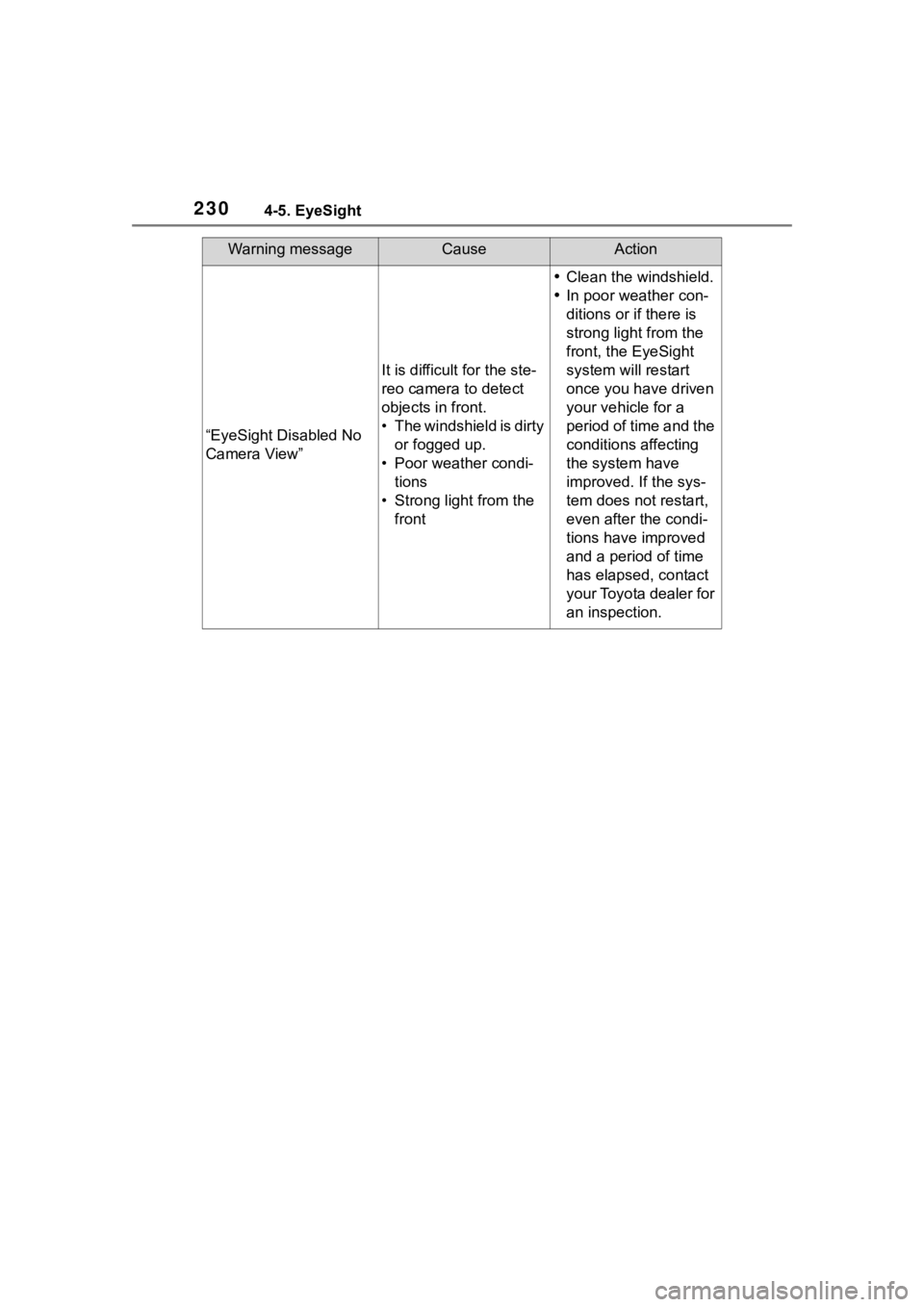
2304-5. EyeSight
Warning messageCauseAction
“EyeSight Disabled No
Camera View”
It is difficult for the ste-
reo camera to detect
objects in front.
• The windshield is dirty or fogged up.
• Poor weather condi- tions
• Strong light from the front
Clean the windshield.
In poor weather con-
ditions or if there is
strong light from the
front, the EyeSight
system will restart
once you have driven
your vehicle for a
period of time and the
conditions affecting
the system have
improved. If the sys-
tem does not restart,
even after the condi-
tions have improved
and a period of time
has elapsed, contact
your Toyota dealer for
an inspection.